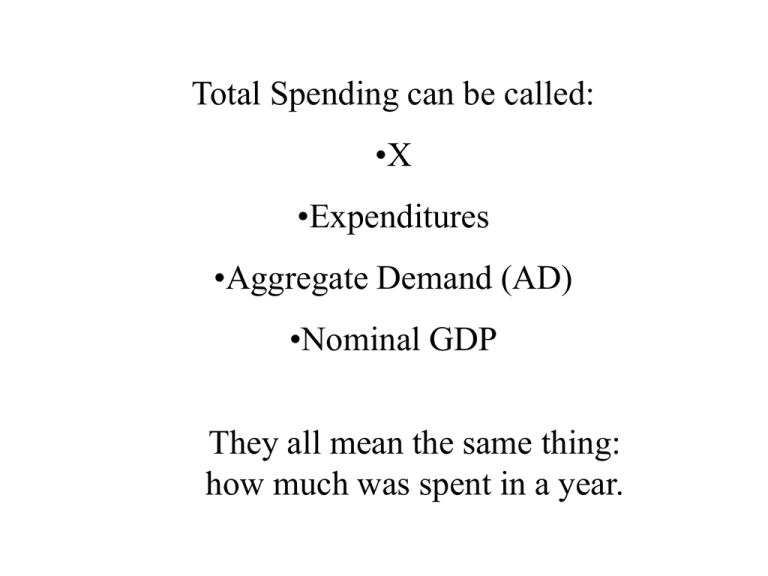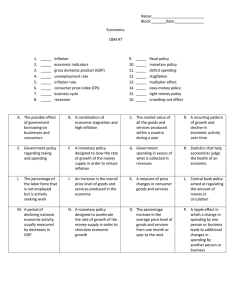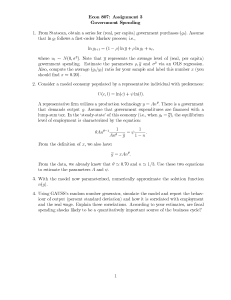Total Spending can be called: •X •Expenditures •Aggregate Demand (AD)
advertisement

Total Spending can be called: •X •Expenditures •Aggregate Demand (AD) •Nominal GDP They all mean the same thing: how much was spent in a year. From CirF we take PRINCIPLE 1: Total Spending (X) can change only if there is a change of a monetary variable. There are two monetary variables: -- the money supply -- money demand X can rise if (a) the money supply is increased or (b) liquidity demand is reduced. We can summarize this with the Credit Market Equation: x = m + v x = m + v. The Credit Market Equation x stands for the (rate of change of) total spending. m stands for the (rate of change of) the money supply. This is substantially controlled by the government agency, the Federal Reserve. The equation says that one way to get more spending (x) is to increase the money supply (m). x = m + v. The Credit Market Equation v stands for the (rate of change of) the velocity of money. It measures how fast money moves through the economy. •The equation shows that another way to get an increase of spending is to have a higher velocity of money. (v x) •Velocity moves opposite liquidity demand: The more people hold money, the slower it moves. •That is: The greater is liquidity demand, the less is the velocity of money x = m + v. The Credit Market Equation (con’t) To repeat: The Credit Market Equation says that the two ways to get more spending are: • the Fed can print more money or • the public can hold less liquidity so as to raise velocity. x = m + v. The Credit Market Equation (con’t.) Factually, x and m are very similar Quarterly, since 1960 Quarterly, since 2000 x = 7.2% x = 5.0% m = 7.1% m = 6.4% This means that we can roughly say, over long periods: v = 0 and x = m Data from FRED x = m + v. The Credit Market Equation (con’t.) x = m means that, over long periods, total spending grows at the same rate as the money supply. Apparently, over time, the demand for liquidity hasn’t changed much. Over long periods, total spending grows at the same rate as the money supply. This suggests that: •the people who control the money supply (the Fed) might be important •we should print lots of money, get lots of spending, which will create lots of jobs and we will all be better off. Just kidding: If it were that easy, everyone would be rich Why can’t we print ourselves rich? Inflation. •An overall increase in the prices of goods. •A rise in the “cost of living.” •A reduction in the value of money Inflation is defined by some as a sustained increase in prices. That is, it needs to last a while before it’s considered inflation. Is money important? Does money matter to the economy? No, in the very short run (a few months), changes of the money supply may have little effect. Yes, in the slightly longer run. The quantity of money seems closely related to total spending which is important to how the economy behaves. No, in the long run. Printing more money just causes higher prices and doesn’t affect any real variables such as employment and the standard of living. There is an equation that relates spending, prices and real changes x = p + q The Product Market Equation x = the growth rate of spending p = the inflation rate q = real growth rate q = x – p is the part of spending that didn’t get turned into inflation. It represents the real increase of goods and services produced. x = p + q. The Product Market Equation (con’t.) Since 1960 Since 2000 x = 7.2 x = 5.0 p = 4.3 So: q = 2.9 p = 2.9 So: q = 2.1 Data from FRED Start again with PRINCIPLE 1: Total Spending (X) can change only if there is a change of a monetary variable. That means: Without a change of a monetary variable, if any one sector increases its spending, then the spending of some other sector(s) must be decreased. We say that the expanding sector is “crowding out” the other sector. Crowding out: The decline in one sector’s spending that occurs as a result of increased spending by some other sector. (“I spend more so you spend less” means that you are being crowded out. ) Crowding out is shown in the closed model. In that model any increase in one sector’s spending results in a decrease in another sector’s spending. That is, the increasing sector has crowded out the decreasing sector. So where does real long run growth come from? Why is our standard of living higher than it was 100 years ago? What causes real growth? PRINCIPLE 2: Long run, real economic growth is the result of increases in the quantity and quality of the factors of production. What causes real Long Run growth? Increases in the quantity and quality of the FACTORS of PRODUCTIONS Land raw materials Labor quality = human capital Capital quality = technology The economy in the SHORT RUN The economy in the LONG RUN is largely controlled by the level of spending which is largely controlled by the quantity of money and credit. is largely controlled by the quantity and quality of the factors of production. Money matters. The levels of spending and money are less important in the long run because of inflation. The economy in the SHORT RUN The economy in the LONG RUN Money matters. Money doesn’t matter. v can change as people v = 0 over time. hold more or less money. Changes of m get people Printing money causes to spend more. This can inflation. cause inflation and/or real growth. Credit Market Equation: x = m + v Product Market Equation: x = p + q So: m + v = p + q. In Long Run v = 0, so m = p + q q is growth due to changes of the factors of production, unrelated to m or x. So m = p + q Since m = q + p, we might consider a plan for zero inflation. What would the plan be? That’s all for now


